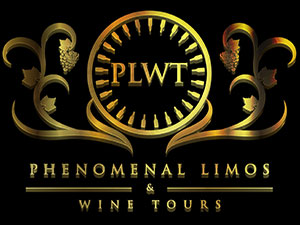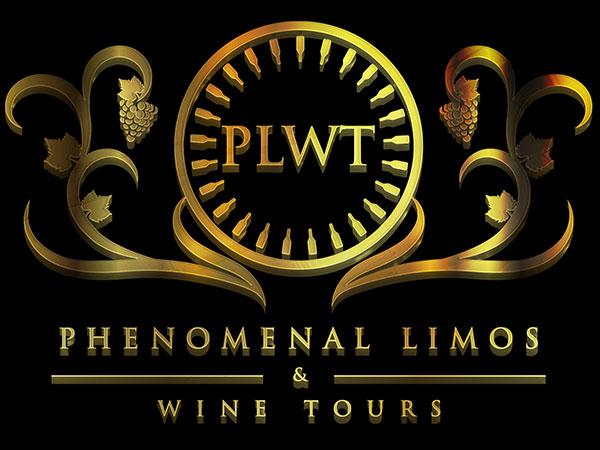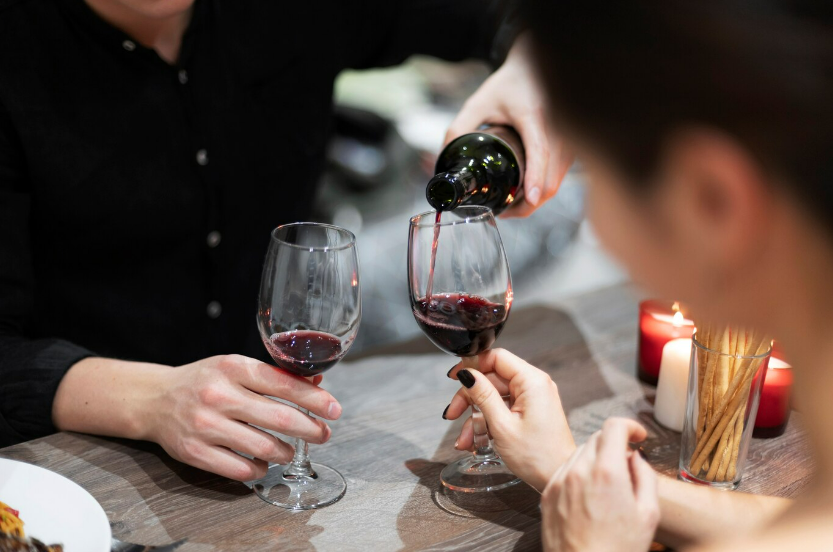
Wine tasting can be an intimidating experience, especially for beginners. With all the swirling, sniffing, and technical terms thrown around, it’s easy to feel lost. But fear not! Wine tasting is ultimately about enjoyment and exploration. This guide will equip you with the essential steps to approach a wine tasting with confidence, allowing you to discover new favorites and appreciate the complexities of this delicious beverage.
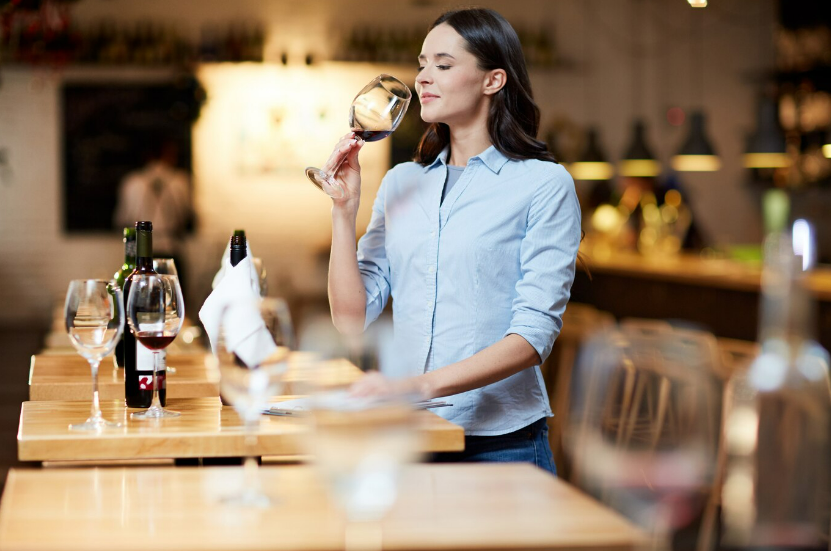
Demystifying Wine Tasting
Wine tasting, for many, conjures up images of snooty connoisseurs swirling glasses and spouting out obscure vocabulary. But the truth is far more welcoming! At its core, wine tasting is about exploration, enjoyment, and learning. It’s a journey to discover the vast and fascinating world of wine, where each sip unveils a new story waiting to be told.
The Joy of Discovery:
Imagine yourself as a culinary explorer, embarking on a voyage across continents and climates. With every wine you taste, you’re transported to a specific vineyard, where the grapes basked under the Tuscan sun or weathered the cool breezes of the Pacific Northwest. You’re tasting the influence of the soil, the winemaker’s artistry, and the unique characteristics of each grape varietal. Each sip becomes a portal to a new experience, a chance to expand your palate and appreciate the incredible diversity of this beloved beverage.
Learning Through Experience
Wine tasting is an interactive learning experience. Unlike memorizing facts from a textbook, you’re actively engaging your senses to understand the intricacies of wine. By observing the color, swirling to release the aromas, and savoring the flavors, you begin to build a vocabulary and understanding of the different components that contribute to a wine’s unique character. You learn to differentiate between a crisp Sauvignon Blanc bursting with citrus notes and a bold Cabernet Sauvignon full of dark fruit and earthy undertones. As you taste more wines, you’ll start to recognize patterns and connect the dots between grape varieties, winemaking techniques, and the resulting flavor profiles.
Putting Enjoyment First
While there’s a certain amount of knowledge you can gain through wine tasting, the most important aspect is simply enjoyment. There’s no pressure to be a sommelier or impress anyone with your expertise. The beauty lies in the personal connection you form with each wine. Does a particular Pinot Noir remind you of a cozy evening by the fireplace? Does a vibrant rosé evoke memories of a summer picnic? Wine tasting is all about finding wines that resonate with you, that complement a meal, or simply bring you a moment of pleasure.
Ditching the Intimidation Factor
One of the biggest misconceptions about wine tasting is that it’s a competition to see who can identify the most obscure flavors or boast the most knowledge. This couldn’t be further from the truth! Forget the intimidation tactics and embrace the spirit of discovery. If you’re unsure about a particular aroma, don’t hesitate to ask questions. The best wine professionals are passionate about sharing their knowledge and helping others experience the joy of wine. So relax, grab a glass, and get ready to embark on your own unique wine tasting adventure!
Benefits of Wine Tasting: A Deeper Dive
Wine tasting goes beyond simply drinking wine. It’s a multi-sensory experience that unlocks a whole new world of appreciation and enjoyment. Here’s a closer look at the key benefits:
Enhanced Appreciation for Wine
Just like learning about music theory allows you to appreciate a symphony on a deeper level, wine tasting equips you to understand the complexities of this beverage. You’ll be able to identify subtle nuances in flavor and aroma, recognize the influence of grape varietal and winemaking techniques, and truly appreciate the craftsmanship behind a well-made wine.
Develop Your Palate and Sensory Skills
Similar to training your ear to recognize different musical notes, wine tasting refines your palate. You’ll learn to distinguish between primary, secondary, and tertiary aromas, identify the basic tastes (sweetness, acidity, bitterness, tannin, and alcohol), and understand how they interact to create the overall flavor profile. Over time, your ability to discern subtle differences in wines will become increasingly sophisticated.
Learn About Different Grape Varietals and Wine Regions
Wine tasting is a gateway to exploring the vast world of grapes and regions. You’ll discover how different grape varietals, like Cabernet Sauvignon or Pinot Noir, express themselves uniquely. You’ll learn about the impact of terroir (climate, soil composition, topography) on wine styles. Imagine tasting a crisp Sauvignon Blanc from New Zealand’s cool climate and then comparing it to the richer, rounder expression of the same grape from California’s warmer vineyards. These comparisons deepen your understanding of how wine is shaped by its origins.
Discover New Wines You Might Enjoy
Wine tasting allows you to step outside your comfort zone and explore unfamiliar territory. You might discover a grape varietal you never knew you loved or find a region that produces wines that perfectly suit your palate. Stepping away from your usual choices can be a delightful adventure, opening doors to new favorites that might become your go-to wines.
Add a Fun Social Element to Gatherings
Wine tasting is a fantastic way to connect with friends and family. It creates a shared experience where you can learn from each other’s observations and preferences. Discussing the wines you’re tasting fosters conversation and lighthearted competition as you try to identify aromas or guess the grape varietal. It adds a layer of fun and engagement to social gatherings.
Setting the Stage for a Successful Tasting: Preparation is Key
Before embarking on your wine tour and tasting journey, a little preparation can significantly enhance your experience. Here are some key steps:
Choosing a Tasting Format:
- Guided Tasting: Ideal for beginners, a guided tasting features a knowledgeable host who will lead you through the wines, explaining their characteristics and answering your questions.
- Blind Tasting: A more challenging but rewarding experience, blind tastings remove preconceived notions based on label or reputation. Here, you focus solely on the sensory evaluation of the wine.
- Self-Guided Exploration: If you’re already familiar with the basics, a self-guided tasting allows you to explore wines at your own pace, focusing on those that pique your interest.
Selecting Wines:
- Varietals: Consider the types of grapes you enjoy or are curious about. Perhaps you’d like to compare different expressions of the same grape from various regions.
- Regions: Explore the wines of a specific region known for a particular style, like the bold reds of Napa Valley or the crisp whites of Burgundy.
- Price Points: Set a budget for your tasting. You can find excellent wines at all price ranges.
- Personal Preferences: Ultimately, choose wines that sound interesting to you. Don’t be afraid to experiment!
Preparing Your Palate:
- Avoid Strong Flavors: Steer clear of foods with strong spices or lingering flavors for at least an hour before the tasting. These can overpower your palate and make it difficult to accurately perceive the nuances of the wine.
- Hydration is Key: Drinking plenty of water throughout the tasting helps cleanse your palate between sips. This allows you to appreciate each wine with a fresh perspective.
- Neutral Snacks: Having crackers or plain bread on hand can also be helpful for neutralizing your palate between tastings.
Essential Tools for Wine Tasting
While not strictly necessary, having the right tools can elevate your wine tasting experience.
Wine Glasses
- Universal Wine Glass: A versatile option suitable for a wide range of wines. These glasses have a rounded bowl that allows for swirling and concentrates the aromas.
- Red Wine Glasses: Typically larger than universal glasses, these have a wider bowl that promotes aeration and allows the red wine’s complex aromas to develop.
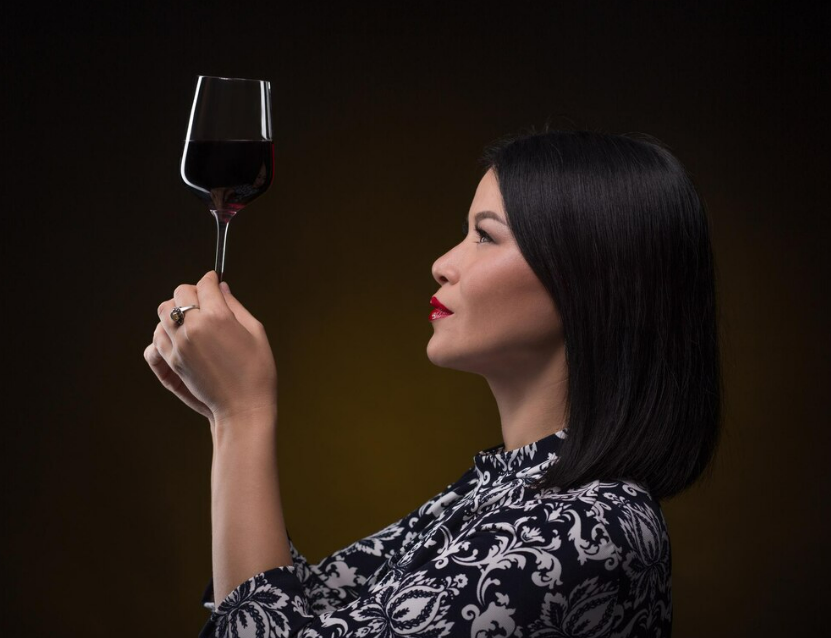
The Art of Wine Tasting: The Five Senses
See: Inspecting the Wine Visually
Holding the Glass
- Etiquette dictates holding the glass by the stem. This prevents your hand from warming the wine, which can alter its taste and aroma.
- Grip the stem towards the base for a more secure hold, or near the bowl for a more casual setting.
- Holding by the bowl can also be helpful for swirling without creating a mess.
Clarity and Color
- A clear wine generally indicates good quality. Cloudiness might suggest a flaw, such as improper filtration or bacterial contamination.
- The color of the wine can reveal its grape varietal, age, and potential style.
- Reds: Younger red wines tend to be a vibrant purple or ruby red, while older reds might show a more garnet or brick-red hue.
- Whites: Younger white wines often display a pale yellow or straw color, while aged whites may develop a deeper golden hue.
- Rosés: Rosés range from pale pink to salmon-colored, with deeper shades indicating more intense flavors.
- Observing the color along the rim (holding the glass up to a white background) can be helpful. For example, a red wine with a watery edge might be lighter-bodied, while a thicker rim could indicate a fuller-bodied wine.
By tilting the glass slightly and holding it against a white background (like a napkin), you can better discern the color’s nuances. Look for variations within the main hue, which can hint at the wine’s complexity.
Viscosity (optional)
Viscosity refers to the “thickness” or resistance of the wine as it flows in the glass. Swirling the glass and observing how the wine clings to the sides can provide clues about its body and alcohol content.
- High Viscosity: If the wine leaves thick, slow-moving streaks (legs or tears running down the glass), it suggests a higher alcohol content or residual sugar, which translates to a fuller-bodied wine.
- Low Viscosity: Conversely, wines with thin, fast-falling legs tend to be lighter-bodied with lower alcohol or sugar levels.
However, it’s important to note that viscosity isn’t always a definitive indicator. Other factors like grape varietal and winemaking techniques can also influence leg formation. Don’t rely solely on this aspect, but consider it as part of the overall visual assessment.
Swirl: Releasing the Wine’s Aromas
Swirling is perhaps the most recognizable and visually striking aspect of wine tasting. But beyond the elegant twirling motion lies a crucial scientific principle: aeration. Wine is a living beverage that continues to evolve even after bottling. When wine is exposed to air, it allows trapped aromatic compounds to escape and rise to the surface of the glass. These aromatic compounds are the building blocks of a wine’s bouquet, the collection of scents that define its character.
The Science of Aeration
Imagine tiny flavor molecules trapped within the wine. These molecules are what your nose detects when you sniff the wine. However, when the wine is still, these molecules are dispersed throughout the liquid. Swirling gently agitates the wine, creating more surface area at the air-liquid interface. This increased surface area allows those trapped aromatic compounds to break free and rise with the evaporating alcohol.
The Swirling Technique
Here’s how to achieve a successful swirl that maximizes aroma release without spilling a drop:
- Grip the Stem: Hold the glass by the stem, not the bowl. This prevents your body heat from affecting the wine’s temperature.
- Start Slow: Begin with a gentle, circular motion in the base of the glass. Imagine you’re drawing small circles on the table with the bottom of the glass.
- Controlled Movement: The swirl should be deliberate and controlled, not a vigorous shake. You don’t want to create a mini-whirlpool.
- Mid-Glass Focus: Keep the movement contained within the mid-section of the wine, not all the way up to the rim. This prevents spillage and concentrates the aromas.
- Observe the “Legs”: As you swirl, pay attention to the “legs” or “tears” that form on the inside of the glass. These are streaks of wine that run down the sides after swirling and can indicate the wine’s alcohol content and viscosity. More pronounced legs generally suggest a higher alcohol content.
- Swirl in Stages: For some fuller-bodied red wines, you might consider a two-stage swirl. Start with a few gentle circles as described above, then briefly lift the glass a few inches off the table and give it a slightly more vigorous swirl. This additional movement can help release more complex aromas trapped within a denser wine.
- Swirl, Sniff, Repeat: After a few gentle swirls, stop the motion and tilt the glass slightly towards your nose. Take a short sniff to assess the initial aromas. You can repeat the swirling and sniffing process a couple of times to allow a wider range of aromas to emerge.
The Impact of Swirling
By mastering the art of swirling, you’ll unlock a whole new dimension in your wine tasting experience. The additional oxygen exposure will allow you to appreciate the subtle nuances of a wine’s bouquet. You might detect primary fruit aromas like cherry or plum, secondary aromas like vanilla or toast from oak aging, and even tertiary aromas like leather or tobacco in older wines.
Smell: Identifying the Wine’s Bouquet
The nose truly knows when it comes to wine tasting. Smelling, or “nosing” the wine, is arguably the most crucial step in the process. It allows you to unlock a world of aromas that hint at the grape varietal, production methods, and even the wine’s age. Here’s how to delve into the fascinating world of a wine’s bouquet:
The Power of the Sniff
- Short Sniffs: Begin by holding the glass by the stem and tilting it slightly away from you. Take a series of short, shallow sniffs at the opening of the glass. This initial exploration helps identify the most prominent aromas.
- Deep Inhales: Once you’ve become acquainted with the initial burst of aromas, delve deeper. Take a deeper inhale, bringing the glass closer to your nose but not burying it completely. This allows more complex and subtle aromas to emerge.
Unveiling the Layers: Primary, Secondary, and Tertiary Aromas
Imagine the wine’s bouquet as a symphony, with different instruments playing their parts at various stages. Wine aromas can be broadly categorized into three groups:
Primary Aromas: These are the most youthful and vibrant scents, directly linked to the grape varietal used in the wine. They are essentially the essence of the grape captured in liquid form. Some common examples include:
- Red Wines: Red fruits like black cherry, plum, raspberry, strawberry; black fruits like blackberry, cassis; floral notes like violets; herbal hints like thyme, rosemary, eucalyptus.
- White Wines: Citrus fruits like lemon, lime, grapefruit; stone fruits like peach, apricot, nectarine; tropical fruits like pineapple, mango, guava; floral notes like honeysuckle, acacia; herbal notes like grass, hay.
Secondary Aromas: These aromas develop during the fermentation process, primarily influenced by the yeast strain used and the winemaker’s techniques. They add complexity and depth to the overall bouquet. Some typical secondary aromas include:
- Yeast-derived: Bread dough, brioche, toast, butter, popcorn.
- Malolactic fermentation: Buttery, creamy, nutty (diacetyl).
Tertiary Aromas: These aromas emerge with bottle aging, influenced by the wine’s interaction with oak barrels or other storage vessels. They add a layer of sophistication and maturity to the bouquet. Common examples include:
- Oak-derived: Vanilla, baking spice (cinnamon, clove, nutmeg), smoke, cedar, leather.
- Bottle aging: Honey, dried fruit (raisin, prune), toffee, caramel.
Building Your Olfactory Vocabulary
The world of wine aromas is vast and nuanced. As you embark on your wine tasting journey, develop your vocabulary to describe the scents you encounter. Here’s a starting point:
Fruity: Distinguish between different fruit types (red, black, citrus, stone, tropical) and their intensity (fresh, jammy, stewed).
Floral: Identify specific flowers like violets, roses, or honeysuckle.
Herbal: Recognize scents like mint, thyme, rosemary, or eucalyptus.
Spicy: Differentiate between baking spices (cinnamon, clove, nutmeg) and peppery notes.
Earthy: Describe aromas like mushroom, damp soil, or forest floor.
Other: Be creative! You might encounter aromas like smoke, leather, or even minerals.
Remember: Don’t be discouraged if you can’t immediately identify every aroma you encounter. Practice and experience will refine your olfactory skills and allow you to decode the language of a wine’s bouquet with increasing accuracy.
Sip: Savoring the Wine on Your Palate
Now that you’ve admired the wine’s visual characteristics and unlocked its aromatic secrets, it’s time for the main event: the sip. This is where the magic happens, and all the information gathered so far comes together to create a unique taste experience. Here’s how to approach this crucial step:
Taking a Sip: Quality over Quantity
Forget about large gulps! A good wine tasting involves taking a small amount, roughly a teaspoon or a thimbleful. This allows you to savor the nuances of the wine without overwhelming your palate.
Swirling and Coating: A Dance on Your Tongue
Once you have a sip in your mouth, don’t swallow it right away. Instead, gently swish the wine around, coating your entire tongue and palate. This activates all your taste receptors, allowing you to identify the different taste components more effectively. Think of it as giving the wine a little tour of your mouth!
The Symphony of Taste: The Basic Elements
As you swish the wine, your taste buds will identify the following basic tastes:
- Sweetness: This is perceived primarily on the tip of your tongue. It can range from subtle hints of sweetness to full-bodied, dessert-like wines.
- Acidity: This sensation creates a refreshing tartness or tang on the sides of your tongue and can be high, low, or somewhere in between. Acidity plays a crucial role in balancing sweetness and overall mouthfeel.
- Bitterness: Detected at the back of your tongue, bitterness can come from grape skins, seeds, or oak aging. While some bitterness can be pleasant, an excess of it can be unpleasant.
- Tannin: This astringent sensation, often described as drying or puckering, comes from grape skins and seeds. Tannins are most prominent in red wines and contribute to their structure and aging potential.
- Alcohol: While not technically a taste, alcohol can be perceived as a warming sensation in the back of your throat. The level of alcohol can vary greatly between wines and can affect the overall mouthfeel.
Beyond the Basics: Layers of Flavor
The beauty of wine tasting lies in the interplay of these basic elements. They don’t exist in isolation; they work together to create a complex flavor profile. Here’s where your focus and practice come in:
- Balance: A well-balanced wine has all its elements working harmoniously. No single taste overpowers the others, creating a pleasant and cohesive experience. As you taste more wines, you’ll develop your preference for the level of sweetness, acidity, bitterness, and tannin you enjoy.
- Finish: Once you swallow (or spit) the wine, pay attention to the lingering flavors and sensations on your palate. This is called the finish, and it can be short, long, or somewhere in between. A good finish lingers pleasantly, leaving you wanting another sip.
Developing Your Vocabulary: Describing the Taste
As you identify these elements, you can start building your own vocabulary to describe the wine. Here are some common descriptors to get you started:
- Sweetness: Dry, semi-dry, off-dry, sweet
- Acidity: Crisp, bright, tart, high acidity, low acidity
- Bitterness: Slightly bitter, pronounced bitterness
- Tannin: Smooth tannins, grippy tannins, chalky tannins
- Alcohol: High alcohol, low alcohol, warming alcohol
- Overall Impression: Fruity, floral, herbal, spicy, earthy, oaky, mineral
Remember, there are no right or wrong answers when describing a wine. Use words that resonate with you and accurately capture your experience. The more you practice, the more precise and evocative your descriptions will become.
Savor: Reflecting on the Tasting Experience
Now that the wine has danced across your palate, it’s time to delve deeper into the experience. This final stage of tasting is where you transition from active evaluation to reflection, allowing the various elements to coalesce and form your overall impression. Here, the five senses come together in a symphony of taste and memory.
Aftertaste
The aftertaste, also known as the finish, is the lingering sensation that remains on your palate after swallowing the wine. It’s a crucial element in assessing a wine’s quality and complexity. A good aftertaste is persistent but pleasant, gradually fading away rather than leaving a harsh or unpleasant sensation. The duration and character of the aftertaste can tell you a lot about the wine:
Length:
- Short finish: The flavors dissipate quickly, often indicating a lighter-bodied wine or one made with younger grapes.
- Medium finish: The flavors linger for a moderate time, suggesting a more balanced and complex wine.
- Long finish: The taste remains on your palate for a significant duration, often associated with full-bodied, well-aged wines.
Character:
- Fruity: Hints of ripe berries, citrus, or stone fruits suggest a focus on primary fruit flavors.
- Spicy: Peppery or herbal notes may indicate the presence of certain grape varietals or oak aging.
- Tannic: A drying sensation on the tongue and gums is characteristic of red wines with abundant tannins.
- Mineral: Earthy or chalky notes can reflect the influence of the soil where the grapes were grown.
Balance
Imagine a skilled tightrope walker gracefully navigating a high wire. In the world of wine, balance refers to the harmonious interplay of all the elements that contribute to its taste profile. These elements include:
- Sweetness: The amount of residual sugar remaining after fermentation. A balanced wine shouldn’t feel overly sweet or cloying.
- Acidity: The tartness or crispness that provides structure and freshness. Balanced acidity complements the other flavors and keeps the wine lively.
- Bitterness: A subtle bitterness can come from grape skins or tannins. In moderation, it adds complexity and can pair well with food.
- Tannins: Astringent compounds found in red wine grape skins and seeds. Balanced tannins provide structure and mouthfeel but shouldn’t overwhelm the other flavors.
- Alcohol: The warming sensation of alcohol. Balanced alcohol should complement the body and flavors of the wine, not overpower them.
When these elements are present in the right proportions and work together seamlessly, the wine achieves a sense of harmony. This balance is a hallmark of a well-made and enjoyable wine.
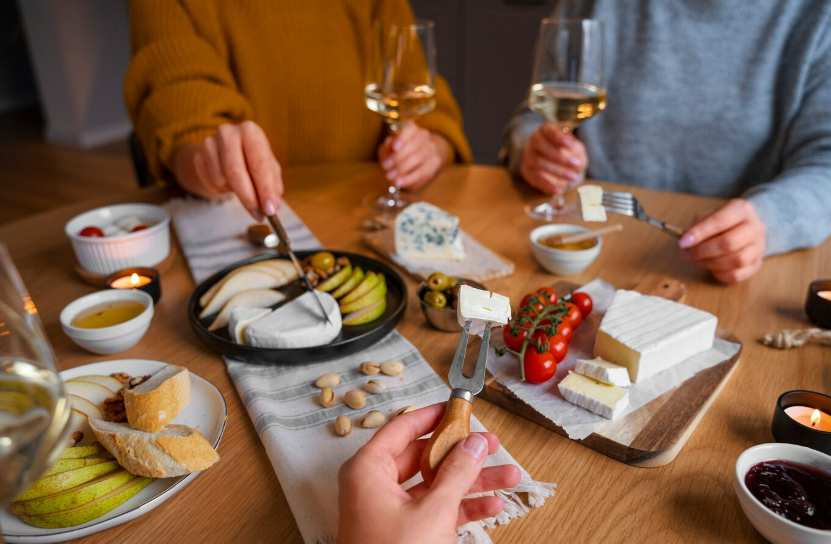
Beyond the Basics: Advanced Wine Tasting Techniques
Blind Tasting: Challenging Your Palate
Blind tasting is a technique where the identity of the wine is hidden from the taster. This removes any preconceived notions about the grape varietal, region, or reputation of the wine, forcing you to rely solely on your senses to evaluate its characteristics.
Advantages of Blind Tasting:
- Focuses on Sensory Evaluation: By removing the label, you’re not influenced by brand recognition, price point, or preconceptions about a particular grape varietal. This allows you to concentrate on the wine’s actual color, aroma, taste, and overall impression.
- Develops Your Palate: Blind tasting pushes your palate to identify subtle nuances in the wine. You become more adept at recognizing primary, secondary, and tertiary aromas, as well as differentiating between different grape varietals and regions based solely on their sensory characteristics.
- Levels the Playing Field: If you’re tasting with a group of people with varying levels of wine knowledge, blind tasting ensures everyone is on an equal footing. It creates a more objective and engaging tasting experience.
- Boosts Confidence: Successfully identifying a wine through blind tasting can be incredibly rewarding. It builds confidence in your sensory evaluation skills and allows you to trust your palate.
Tips for Successful Blind Tasting:
- Pay Close Attention to Color: Observe the wine’s hue, intensity, and clarity. Lighter colored wines are typically white or young reds, while deeper colors can indicate bolder reds or aged wines.
- Employ the “See, Swirl, Sniff, Sip, Savor” Method: Even without knowing the wine’s identity, follow the basic steps of wine tasting. Each step provides valuable clues about the wine’s characteristics.
- Focus on Aromas: Analyze the intensity, complexity, and specific aromatic components. Are there primary fruit notes? Secondary aromas like yeast or butter? Tertiary hints of oak or vanilla?
- Identify Taste Components: On the palate, pay close attention to sweetness, acidity, bitterness, tannins, and alcohol level. How do these elements interact and create the overall flavor profile?
- Consider the Finish: Notice the length of the aftertaste and any lingering flavors.
- Take Notes: Jot down your observations about color, aroma, taste, and overall impression. After everyone has tasted, reveal the wines and compare your notes to the actual varietals and regions.
Food Pairing: Enhancing the Experience
Food and wine pairing is an art form that elevates both the culinary and the wine tasting experience. When done well, the right food can enhance the flavors of the wine and vice versa.
How Food Can Complement and Elevate the Taste of Wine
- Balancing Acidity and Richness: High-acid wines can cut through the richness of fatty foods, creating a more harmonious taste sensation. Conversely, bold, tannic wines can pair well with fatty cuts of meat because the tannins help cleanse the palate.
- Complementing Flavor Profiles: Wines with similar flavor profiles to the food can create a sense of synergy. For example, a fruity Sauvignon Blanc pairs beautifully with fresh seafood dishes that share similar citrusy notes.
- Contrasting Flavors: Sometimes, contrasting flavors can create an interesting interplay. A sweet dessert wine can complement a salty cheese by highlighting the contrasting elements.
Basic Principles of Food Pairing
- Consider Weight: Match the weight of the wine to the weight of the food. Lighter wines pair well with lighter dishes (think fish and salads), while bolder wines complement heavier meals (like red meat and stews).
- Acidity is Key: High-acid wines tend to pair well with rich foods and fatty cuts of meat. Conversely, low-acid wines can complement spicy dishes.
- Flavor Profiles: Look for complementary or contrasting flavors between the wine and the food.
- Regionality: Consider traditional pairings from the wine’s region. For example, Italian wines often pair well with Mediterranean cuisine.
Examples of Successful Food and Wine Pairings
- Sauvignon Blanc with Oysters: The wine’s crisp acidity cuts through the briny oyster flavor, creating a refreshing and clean finish.
- Pinot Noir with Salmon: The light-bodied Pinot Noir complements the delicate flavors of salmon without overpowering it.
- Cabernet Sauvignon with Steak: The bold tannins in Cabernet Sauvignon stand up to the richness of a well-marbled steak, cleansing the palate between bites.
- Riesling with Spicy Food: The sweetness and acidity in Riesling help balance the heat of spicy dishes.
Taking Notes: Documenting Your Discoveries
Taking notes during a wine tasting is an essential practice for any aspiring wine enthusiast. It allows you to capture your fleeting impressions and preferences, creating a valuable record for future reference. Imagine revisiting a particularly intriguing wine months later – your detailed notes can unlock a flood of memories, allowing you to compare and contrast it with other wines you’ve experienced.
Here’s a breakdown of what to include in your wine tasting notes:
Date and Location:
Start with the basic details – the date of the tasting and the location (winery visit, tasting room, or even a friend’s gathering). This helps contextualize your experience and jog your memory later when revisiting your notes.
Wine Information:
Note down the wine’s name, grape varietal(s), and vintage (year of harvest). Knowing the grape varietal is crucial, as it provides a foundation for what flavor profile to expect. The vintage can also be insightful, especially for wines that age well. Some tastings might offer additional details like the region, producer, and alcohol content – capture these too, if available.
Visual Inspection:
Describe the wine’s color in detail. Move beyond simple terms like “red” or “white.” For reds, note the variations – is it ruby red, garnet red, or perhaps a more mature brick red? For whites, describe the intensity of color – is it pale yellow, straw yellow, or a deeper gold? You can even mention the clarity and brilliance of the wine.
Aroma:
This is where your note-taking gets exciting. Start by recording your initial impressions upon first sniff. Is the aroma subdued or intense? Are there any obvious primary fruit aromas related to the grape varietal (e.g., black currant for Cabernet Sauvignon)? Then, swirl the glass and take a deeper sniff. Here’s where you might encounter secondary aromas developed during fermentation (e.g., yeasty, bready) or tertiary aromas influenced by aging (e.g., oak, vanilla, smoke). Use descriptive terms – is the oak subtle or overpowering? Does the vanilla have a creamy or spicy character? Don’t be afraid to get creative!
Taste:
Move on to the tasting experience. Describe the wine’s body – is it light-bodied, medium-bodied, or full-bodied? Think about the texture – is it smooth and silky, or perhaps grippy with tannins? Then, identify the basic tastes: sweetness (ranging from dry to off-dry to sweet), acidity (ranging from crisp and lively to low and mellow), bitterness, tannin (present mainly in red wines and contributing to a drying sensation), and alcohol (noticeable warmth or a smooth integration). How do these elements interact with each other? Is the wine balanced and harmonious, or do certain flavors overpower others?
Overall Impression:
Finally, capture your overall impression of the wine. Did you enjoy it? What flavors or characteristics stood out the most? Would you pair it with food? If so, what kind of food would complement it best? This final note allows you to summarize your experience and form a lasting memory of the wine.
Conclusion
Your wine tasting adventure is a journey of discovery fueled by preparation, exploration, and enjoyment. From setting the stage with the right tools to meticulously analyzing each sip, the “See, Swirl, Smell, Sip, Savor” approach unlocks a world of sensory delights. Embrace the learning process, but remember, personal preference reigns supreme. As your confidence grows, delve into blind tasting and food pairing to truly challenge your palate. Don’t stop there! Expand your horizons by attending diverse tastings, visiting wineries, and experimenting with new grape varietals. Develop your own vocabulary to describe the nuances you encounter, and document your journey in a wine tasting journal. As you explore, remember, the most important element is the joy you experience with each delicious sip.
